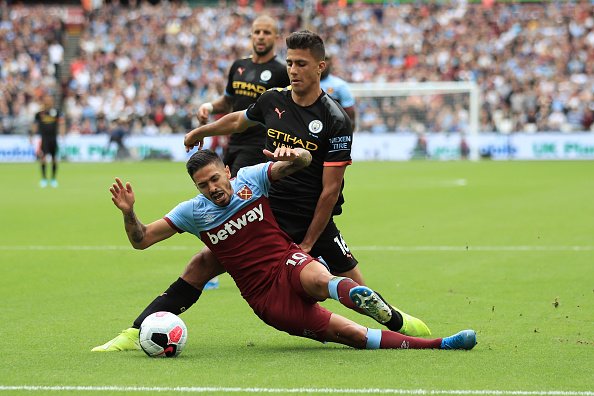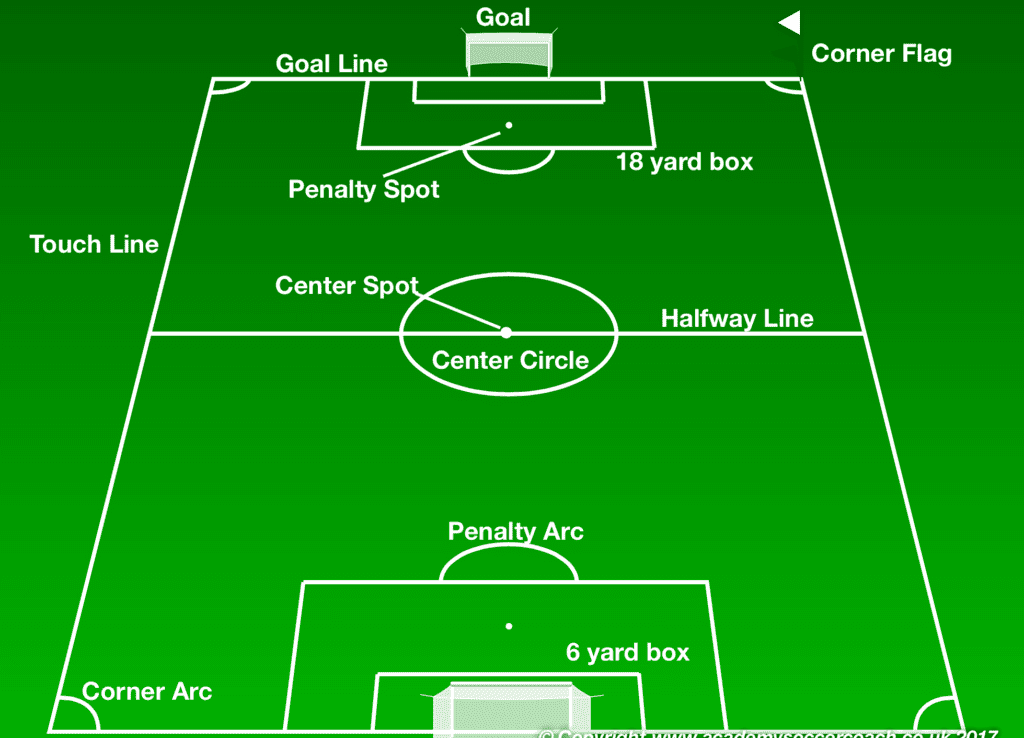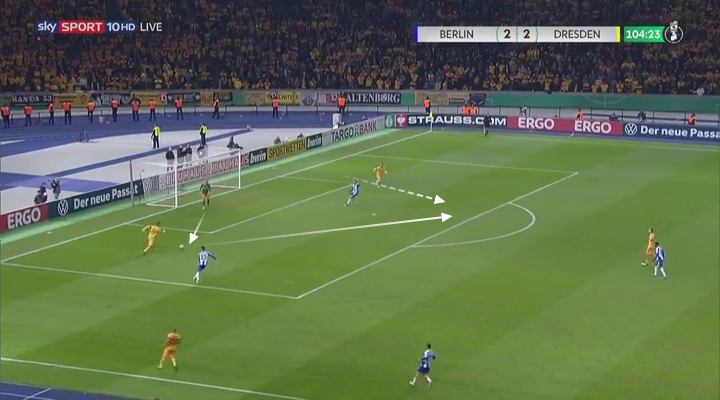- Last Updated -
Soccer Law #8 – soccer start and restart of play
Soccer, known as football in many parts of the world, is undeniably one of the most beloved and widely played sports globally. With its origins dating back centuries, soccer has captivated hearts and minds with its beautiful simplicity and exhilarating moments.
From tiny villages to grand stadiums, this sport transcends cultural boundaries and unites people from all walks of life. The importance of understanding the start and restart of play in soccer cannot be emphasized enough.
These crucial moments shape the dynamics and flow of the game, determining teams’ strategies and players’ actions throughout a match. Recognizing when a game starts or recommences after an interruption ensures that both players and spectators are fully aware of the rules governing these pivotal instances.

Brief Overview: Soccer as a Popular Sport Worldwide
Soccer’s popularity stems from its accessibility, simplicity, and universal appeal. It has woven itself into the tapestry of numerous societies around the globe, captivating hearts with its blend of skillful technique, strategic prowess, teamwork, and sheer passion.
From Brazil’s samba style to Spain’s tiki-taka passing game or Germany’s disciplined efficiency – each nation contributes to soccer’s rich tapestry through their distinctive playing styles.
The sport’s prominence can be witnessed in international tournaments such as the FIFA World Cup or UEFA Champions League where nations compete fiercely to secure glory on a global stage.
The camaraderie formed within fan bases further solidifies soccer as more than just a game; it becomes an emblem that unifies cultures under one banner – united by their shared love for this enthralling sport.
Moreover, soccer serves not only as entertainment but also as an economic powerhouse driving immense revenue through merchandise sales, broadcasting rights deals, sponsorship agreements, and ticket sales.
Stadiums are filled with passionate supporters who create an electrifying atmosphere that can stir raw emotions, forming an indelible bond between players, fans, and the game itself.
Importance of Understanding the Start and Restart of Play in Soccer
To fully comprehend a soccer match’s ebb and flow, it is imperative to grasp the intricacies of how the play starts or resumes after a stoppage. These instances – encompassing kick-offs, restarts after goals are scored, throw-ins, goal kicks, and corner kicks – all possess their own unique rules and considerations that players must adhere to.
Understanding the start and restart of play grants players a tactical advantage by allowing them to exploit potential gaps in their opponent’s formation. It provides an opportunity to seize control from the opening whistle or regain momentum following a momentary pause.
Additionally, comprehending these aspects enables referees to officiate matches effectively by ensuring fair play and enforcing regulations consistently. Spectators also benefit from understanding these nuances as it deepens their appreciation for the game.
Witnessing how teams approach kick-offs or capitalize on goal restarts offers insight into their strategic approach. Moreover, being well-versed in these aspects fosters engagement and lively conversations among fans as they dissect each team’s choices during critical moments.

The Kick-off
Definition and Purpose of the Kick-off
The kick-off is the starting point of a soccer match, where a player from the team that won the coin toss takes a stationary position in the center of the field. The purpose of the kick-off is to initiate play and determine which team gains possession of the ball.
This crucial moment sets the tone for the entire game, igniting anticipation and excitement among players and spectators alike. Steeped in tradition, this ritual marks the beginning of tactical strategies, skillful maneuvers, and thrilling encounters on the pitch.
Positioning and Rules for Players During the Kick-off
During a kick-off, both teams have specific rules to adhere to ensure fair play. The team taking the kick positions all its players within its own half while their opponents must be outside both halves until after kickoff has taken place.
This positioning ensures that no player from either side gains an unfair advantage by being too close to their opponents’ goal or disrupting play before it begins.
The Ball Must Move Forward at The Kick-off
Once all players are properly positioned, an exhilarating moment unfolds as the designated player moves toward the ball with purpose and precision. One essential rule during a kick-off is that as soon as contact is made with the ball, it must move forward.
This ensures an immediate engagement between opposing players once play commences. It also prevents slow starts or attempts to retain possession by passing backward right from kickoff.
Opposing Players Must Be Outside The Center Circle Until The Ball Is In Play
To maintain fairness, opposing players are required to remain outside of a designated circle at midfield until after kickoff takes place. This rule prevents any interference with or obstruction of play during this critical moment when control over possession can shift dynamically between teams.
By adhering to this rule, the game ensures a level playing field from the very beginning, allowing players to showcase their skills and compete on equal terms.
By understanding the intricacies of the kick-off, including its definition, purpose, positioning requirements for players, and the rule that mandates forward progress of the ball at this momentous occasion, soccer enthusiasts can truly appreciate the significance of this initial exchange of play.
The kick-off sets into motion a chain of events that ultimately leads to moments of brilliance or disappointment. It serves as a testament to the beauty and complexity inherent in this globally adored sport.
Celebratory Moments after a Goal
Scoring a goal is the pinnacle of achievement in soccer, and it is no wonder that celebratory moments following such an accomplishment are filled with exuberance and ecstasy.
As the ball finds its way into the net, players’ emotions ignite, unleashing an array of reactions that vary from joyous elation to sheer relief.
Some players raise their arms triumphantly, while others sprint toward their teammates with unbridled enthusiasm. These celebratory moments not only reflect the passion and dedication these athletes have for their sport but also serve as a means to bond and unite the team.
Team celebrations are an integral part of soccer’s rich tapestry. When a goal is scored, players converge in jubilation, forming a tight-knit group that radiates unity and camaraderie.
The sight of teammates leaping into each other’s arms or huddling closely in a circle symbolizes the collective effort behind every successful attack. It is during these magical moments when individual egos fade away, making space for shared joy and mutual respect.

Retrieving the Ball from the Net by One of the Goalkeepers
After witnessing unforgettable displays of emotion from both scorers and their teammates following a goal, there comes an essential post-goal ritual – retrieving the ball from within the net.
This task typically falls upon one of the goalkeepers who must approach their own goal with grace amidst reverberating cheers or deafening silence depending on which side triumphed.
The keeper’s stride towards the net embodies resilience as they bravely face defeat in conceding a goal or confidently retrieve a ball they last saw past them due to extraordinary teamwork on their end.
As they reach inside to fish out that spherical object which tormented them momentarily, they do so without losing composure or allowing emotions to overshadow their responsibility.
This act not only signifies a return to the game but also showcases the keeper’s steadfastness, as they reset themselves and prepare for the next challenge.
Center Circle Restart
Once the ball has been retrieved and order restored, soccer embraces its symmetrical nature by restarting play from the center circle.
The team who conceded the goal now has a chance to redeem themselves as they initiate this pivotal moment in the match. The players gather around, positioning themselves strategically within their respective halves of the field.
A sense of anticipation fills each player’s mind, knowing that this restart holds immense significance in shaping the course of play that follows. As the referee signals, one player ceremoniously places the ball on the center spot, ready to engage in a delicate dance with their foot that catapults this spherical object into motion once more.
However, before unleashing their next assault on goal, it is crucial to note that opposing players must respect an imaginary boundary delineated by a circle around this sacred spot. They must wait patiently outside this marked territory until contact is made with the ball – at which point all boundaries are erased and battle resumes anew.

Restarts after Ball Out of Play (Throw-ins)
Definition and Purpose of Throw-ins
A crucial aspect of soccer is the restarts that occur when the ball goes out of play. One such restart is the throw-in, which is awarded to the opposing team when the ball completely crosses the touchline, either on the ground or in the air.
The purpose of a throw-in is to resume play fairly and safely while ensuring that both teams have an equal opportunity to regain possession. This particular restart requires players to utilize specific techniques for successful execution.
Proper Technique for Executing a Throw-in
The proper technique for executing a throw-in entails adherence to certain rules and principles set forth by official soccer regulations.
Firstly, when taking a throw-in, the player must have both feet on or behind the touchline. By doing so, they ensure that they are positioned correctly and provide no unfair advantage or disadvantage to either team.
This positioning also allows for an accurate assessment of where teammates are positioned on the field, facilitating strategic decision-making. Furthermore, during a throw-in, players need to follow specific guidelines regarding their throwing motion.
The player should grasp the ball with both hands firmly and release it from behind their head while simultaneously propelling it forward toward teammates in an overhead motion. The release point should be above and slightly behind their head, enabling increased distance and accuracy in delivering the ball back into play.
The Player Must Have Both Feet on or Behind Touchline While Throwing
As mentioned earlier, one crucial rule during a throw-in involves ensuring that both feet remain grounded on or behind the touchline until after releasing the ball into play.
This requirement guarantees fairness by preventing players from gaining an unfair advantage by stepping onto or overstepping boundaries before executing their throw-in. Adhering strictly to this rule maintains the integrity of the restart, allowing for a level playing field and equal opportunities for both teams involved.
The Throw-in Should Be Taken with Both Hands, Releasing It from Behind and Over Their Head
Another key aspect of executing a proper throw-in is the method employed by the player. According to soccer regulations, the thrower must use both hands to hold the ball during its release.
This ensures stability and control, minimizing chances of fumbling or losing grip mid-throw. Additionally, releasing the ball from behind and over their head allows for a more forceful throw with improved accuracy.
By utilizing this technique, players can propel the ball further into play and provide their team with better opportunities to regain possession or create scoring chances. Throw-ins serve as one of soccer’s essential restarts after the ball goes out of play.
Players must adhere to specific rules governing their execution to maintain fairness on the field. Ensuring that both feet remain on or behind the touchline while throwing guarantees an even playing field for all involved parties.
Furthermore, employing a throwing technique involving both hands and releasing from behind and over their head facilitates accurate deliveries back into play. Mastering these techniques equips players with a competitive edge in executing successful throw-ins during intense matches

Restarts after the Ball is Out of Play (Goal Kicks)
Definition and Purpose of Goal Kicks
A goal kick is a method of restarting play in soccer when the attacking team has kicked the ball out of bounds over the opponent’s goal line, but not into the goal. This restart occurs from within the defending team’s penalty area.
The purpose of a goal kick is to allow the defending team to regain possession and initiate an attack from a controlled position on the field. It allows them to reset their defensive structure and strategically distribute the ball to their teammates to build up their play.
Rules for Executing a Goal Kick
Executing a goal kick requires adherence to specific rules set by governing bodies such as FIFA. Firstly, only the goalkeeper is permitted to take a goal kick. The goalkeeper must place the ball anywhere on or within the six-yard box inside their penalty area before initiating play.
Once positioned, they have six seconds to release or distribute the ball into play. During this time, all opposing players must remain outside both the penalty area and its arc until it leaves this designated area.
Furthermore, no member of either team must touch or plays with the ball until it has completely left the penalty area during a goal kick. If an opposing player intercepts or touches the ball before leaving this zone, an indirect free-kick will be awarded to them at that spot inside or on top of the penalty area.
Goalkeeper Takes It Within Their Penalty Area
The responsibility for executing a goal kick lies solely with one player –-the goalkeeper. Positioned within their penalty area, they have complete control over initiating this restart method.
Being entrusted with distributing possession effectively after regaining control allows for tactical advantage and strategic decision-making based on assessing potential passing options downfield.
In addition to their primary role as the last line of defense, goalkeepers must possess excellent kicking abilities to ensure successful goal kicks. Their technique and precision play a vital role in determining the outcome of this restart, as a well-struck ball can quickly transition defensive play into an attacking opportunity for their team.
All Opposing Players Should Be Outside Penalty Area Until Ball is in Play
During a goal kick, all opposing players are required to position themselves outside both the penalty area and its arc until the ball leaves this designated area completely. This rule is put in place to provide space for the defending team’s goalkeeper to initiate play without being subjected to immediate pressure from attackers.
By forcing opposing players outside the penalty area during a goal kick, it creates a fairer and more balanced environment for both teams. Once the ball has left the penalty area after a goal kick, it is considered in play.
At that point, opposing players are free to challenge for possession or engage with their opponents, allowing open competition throughout the pitch. However, any infringement on these rules by either team during a goal kick may result in disciplinary action from match officials or potential turnovers of possession.
Thus, players must be disciplined and maintain proper positioning until they are allowed back into active participation once again.
By understanding and following these rules during a goal kick restart scenario, teams can optimize their opportunities for regaining control of possession while simultaneously ensuring fairness and adherence to established guidelines.

Restarts after the Ball is Out of Play (Corner Kicks)
Definition and Purpose of Corner Kicks
A corner kick in soccer is awarded when the defending team is the last to touch the ball before it crosses the goal line, but not into the net, outside their goalposts.
It grants an offensive opportunity for the attacking team to score a goal. The purpose of corner kicks is twofold: firstly, it allows a team to position their players strategically near the opponent’s goal, creating scoring chances, and secondly, it puts pressure on the defending team as they need to defend against potentially dangerous aerial balls or shots on goal.
When a corner kick is awarded, one player from the attacking team takes up position in the corner arc nearest to where the ball went out. The player holds onto the ball and places it within one yard of that spot.
This creates an ideal starting point for executing various tactics that can catch defenders off-guard. On occasion, teams might opt for a short corner, playing a quick pass instead of attempting a direct cross into the box.
The Artistry Behind Corner Kick Techniques
The execution of a successful corner kick requires precision and coordination among players. A well-placed delivery into the penalty area can create chaos amongst defenders while offering attackers ample chances to head or volley toward the goal.
Various techniques are employed during this restart:
1, In-swinger: The player kicks with their dominant foot from outside-in towards their teammates near or inside the six-yard box.
2. Out-swinger: Here, players use their dominant foot to curl an arching ball away from the goal towards teammates positioned at different angles. 3. Near-post flick-on: Instead of aiming directly at teammates inside or near the six-yard box, sometimes corners are played short towards a player near the post who flicks it on for others lurking in dangerous areas.
Conclusion
In soccer, the restarts after the ball is out of play hold immense significance, and corner kicks are no exception.
These set-piece opportunities provide teams with a chance to capitalize on offensive plays and potentially secure a goal.
The artistry behind executing corner kicks lies in the ability to deliver the ball accurately and unpredictably while attackers position themselves strategically in dangerous areas.
As fans or players of the beautiful game, we can appreciate these moments as they showcase the tactical awareness, skill, and teamwork required to succeed.
So let us revel in the excitement that ensues during these restarts, where dreams are realized, heroes are made, and victories are forged on the pitch. (1)
FAQs - Soccer Law #8 - soccer start and restart of play
What is the significance of understanding soccer’s start and restart of play?
- Understanding the start and restart of play in soccer is crucial as these moments shape the game’s dynamics, influencing teams’ strategies and players’ actions throughout a match.
How does soccer’s popularity manifest globally?
- Soccer’s global popularity is evident from its universal appeal, diverse playing styles across nations, and major international tournaments like the FIFA World Cup and UEFA Champions League. It also serves as an economic driver through merchandise sales, broadcasting rights, and ticket sales.
What tactical advantages do players gain by understanding the start and restart of play?
- Players can exploit gaps in the opponent’s formation and seize control from the opening whistle or regain momentum after a pause, while referees can ensure fair play and consistent rule enforcement.
What are the rules and purposes of a soccer kick-off?
- A kick-off, marking the start of a soccer match, requires the ball to move forward and opposing players to be outside the center circle until the ball is in play. It sets the tone for the game and ensures a level playing field from the beginning.
How are goals celebrated in soccer?
- Goals in soccer are celebrated with exuberance and ecstasy, symbolizing team unity and collective effort. Players often display emotions ranging from joyous elation to relief during these moments.
What happens after a goal is scored in soccer?
- Post-goal, a goalkeeper typically retrieves the ball from the net, showcasing resilience and readiness for the next challenge.
What is the center circle restart in soccer?
- After a goal, play restarts from the center circle, where the team that conceded the goal has the opportunity to redeem themselves. Players must respect an imaginary boundary around the center spot until the ball is in play.
What are the rules and techniques for executing a throw-in in soccer?
- In a throw-in, the player must have both feet on or behind the touchline and use both hands to release the ball from behind their head. This ensures fair play and equal opportunities for both teams.
How are goal kicks performed in soccer?
- Goal kicks are taken by the goalkeeper within their penalty area, with all opposing players outside the penalty area until the ball is in play. This restart allows the defending team to regain possession and initiate an attack.
What is the significance of corner kicks in soccer?
- Corner kicks offer offensive opportunities for the attacking team and require precise delivery and coordinated player positioning. Techniques like in-swingers, out-swingers, and near-post flick-ons are employed to create scoring chances.
The Historical Dominance of Brazilian Soccer in the World Cup
Introduction: The Beautiful Game's Grandest Stage The World Cup, a grand tournament...
Read MoreConcussion Substitutions in Soccer: evolving concussion protocols
The Growing Concern for Player Safety in Soccer Soccer, a beloved sport...
Read More


















